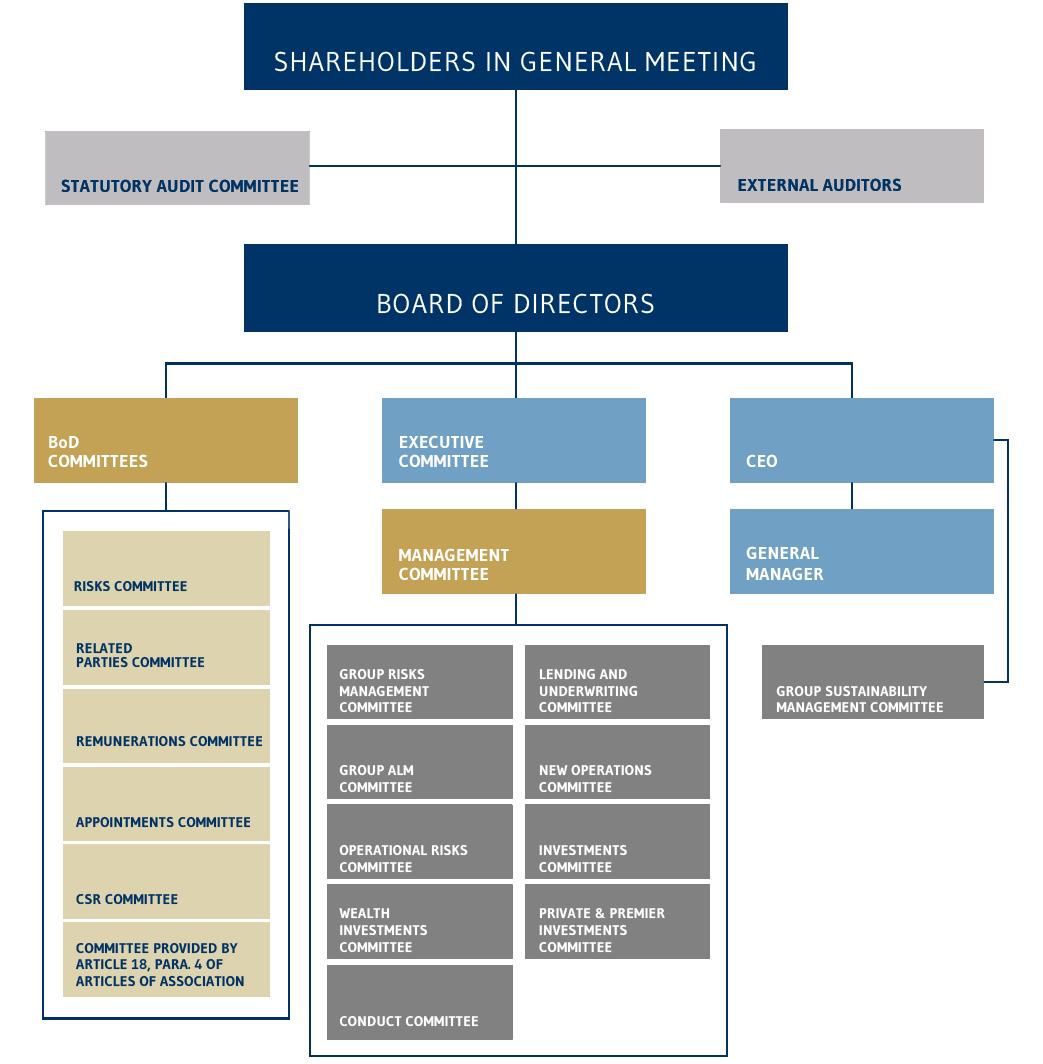
3 minute read
3.2 Governance model
from CNFS22
by Mediobanca
3.2 Governance model
[GRI 102-18], [GRI 102-22], [GRI 102-24], [GRI 405-1]
Mediobanca has adopted a traditional system of governance based on the appointment of a Board of Directors and Statutory Audit Committee by shareholders gathered in annual general meeting.
Within this model, the Group’s governance provides for a clear division of roles and responsibilities between governing bodies, as stipulated in the Articles of Association:
The Board of Directors is responsible for strategic supervision, approving the strategic direction of the Bank and monitoring to ensure it is implemented in practice;
The Leading Independent Director is responsible for co-ordinating independent Directors’ requests and considerations;
Management of the Group is the responsibility of the Executive Committee and the Chief Executive Officer, who are responsible for executing the strategic direction and for managing the company’s day-to-day operations;
The existing model works as follows:
Under the terms of the Articles of Association, the Board of Directors is appointed on the basis of a list voting mechanism in which lists may be submitted by the Board of Directors and/or by shareholders representing at least 1% of the company’s share capital in the aggregate.
The Board of Directors issues its own guidance in the “Report on the Qualitative and Quantitative Composition of the Board of Directors”, to ensure that the list of candidates submitted for appointment are suitably qualified for the responsibilities they will have to assume.
The Directors must be in possession of the qualifications expressly set by the regulations in force and the requisite time commitment; they must comply with the limits on the number of posts held, and not be in any situations of incompatibility pursuant to Article 36 of Italian law nr. 214/11. The majority of the Directors must qualify as independent according to the definition provided in Article 19 of the Articles of Association and the regulations in force, and no-one over the age of 75 may be appointed. The Board’s composition also complies with the law on equal gender representation. Mediobanca acknowledges and welcomes the benefits of diversity in all aspects at Group level and on its own governing bodies, with reference to gender, age, qualifications, capabilities, training and professional profile.
While emphasizing the importance of the Board’s collective suitability, and hence the need for its members, executive and non-executive, to be able to take decisions on a collegiate basis, Mediobanca expects candidates for the position of Bank Director to have the required capabilities to ensure an optimal combination in terms of profiles, in order to promote internal debate, effective functioning, and the collective suitability of the Board and the Board Committees.5 The same considerations apply to the Statutory Audit Committee.
The Board of Directors currently in office consists of 15 members –appointed by shareholders at the Annual General Meeting held on 28 October 2020 – 40% are women, more than half qualify as independent under the definition provided in Article 19 of the Articles of Association, and with two Directors appointed by minority investors, one of whom was recently appointed Lead Independent Director. There are four executive and eleven non-executive members on the Board. For details of the individual Directors’ professional qualifications and areas of competence, please refer to the dedicated section of the Mediobanca website at https://www.mediobanca.com/en/corporate-governance/board-of-directors/composition-and-role.html.
All fifteen Directors are in the “Over 50 years” age bracket.
In accordance with the recommendations made in the Corporate Governance Code and in the Bank of Italy’s Supervisory Instructions on corporate governance, the Board of Directors has instituted the following Committees: Risks Committee, consisting of non-executive Directors, the majority of whom are independent; Remuneration Committee, consisting entirely of non-executive Directors and independent; Appointments Committee, consisting entirely of non-executive Directors, the majority of whom are independent; CSR Committee, consisting of one executive Director and four non-executive members, a majority of whom are independent; and the Related Parties Committee, consisting entirely of independent Directors. The Board of Directors has also appointed an Executive Committee.
The Statutory Audit Committee consists of three standing auditors and three alternate auditors, appointed by shareholders at the Annual General Meeting held on 28 October 2020 and in office for the 2021, 2022 and 2023 financial years.
The candidate gaining the highest number of votes in the section for standing auditors in the list which






